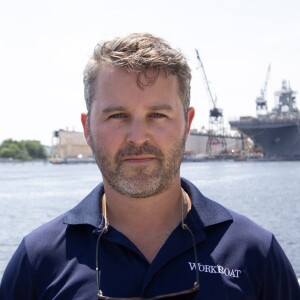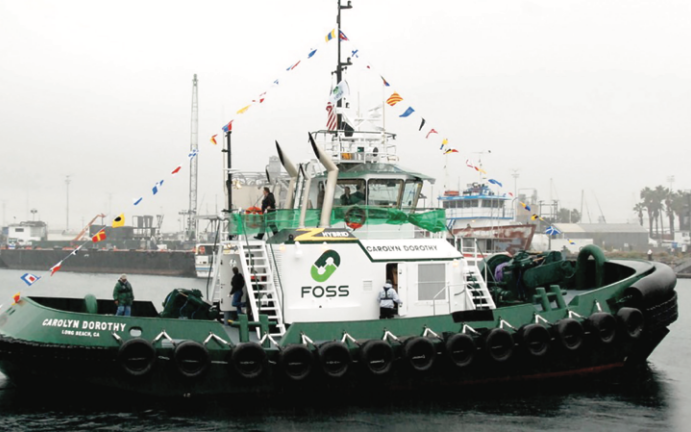The California Air Resources Board (CARB) plans to extend the Commercial Harbor Craft (CHC) emissions rule to include all marine vessels, such as tugboats, towboats, and ferries, excluding fishing vessels.
This expansion aims to reduce particulate matter emissions in California’s coastal communities. CARB approved these amendments in March 2022, which “will require zero-emission options where feasible, and cleaner combustion Tier 3 and 4 engines on all other vessels. In addition, they will require the use of diesel particulate filters (DPFs), which are standard equipment on new cars and trucks,” a CARB press release said.
The marine industry faces a unique challenge compared to ground transportation when it comes to DPFs. Currently, there are no certified DPF solutions tailored to diesel engines found in commercial vessels. CARB officials told WorkBoat that engine and DPF manufacturers are currently working on designing, certifying, and verifying products for this market, but the technology is not yet commercially available.
Jennifer Carpenter, president and CEO of the American Waterways Operators (AWO), expressed concern about the mandate and CARB's implementation timeline. The six-month window provided for DPF installation once the technology becomes available is seen as unrealistic by many in the industry, AWO said. This has raised concerns that many operators might lose their businesses or be forced to relocate to other states.
“California regulators have chosen to take action that could sever a critical link in the supply chain for essential cargo, going into and out of California ports, by requiring technology that hasn't been approved for use on these vessels,” Carpenter told WorkBoat. “That could pose serious risks to the life of mariners and to the marine environment. That doesn't have to happen. We can press pause, and we can figure out how to do this so that we achieve meaningful reductions in emissions. And we do that in a safe way. We can do it, but this (mandate) is a choice not to.”
When asked how mandating non-certified DPFs on a variety of engine types in commercial vessels affects mariner safety, CARB focused on the health of residents inhabiting the coastal communities in California.
“While there is no data indicating that regulatory requirements impact service or commerce, we do know that commercial harbor craft contribute to the persistent air quality issues that make communities near the port some of the most polluted places in the nation. The regulations consider available technology and are projected to have $5 billion in health cost benefits from avoided premature deaths, hospitalizations, and emergency room visits, reduce the pollution-related health impacts from respiratory and cardiovascular disease, and reduce cancer risk to over 22 million residents,” a CARB spokesman said.
Diesel particulate filters are compact aftertreatment devices added to exhaust systems to capture carbon soot particles emitted by diesel engines. They subject the particles to high temperatures (600°F in truck engines), burning them into harmless ash through a process called regeneration. In theory, DPFs have the potential to eliminate 85% to nearly 100% of soot from diesel emissions.
Tug and towboat engines differ significantly from their road vehicle counterparts. The marine engines that California tugboats use operate at lower engine speeds, which require higher burn-off temperatures reaching up to 1,500°F. A big concern for vessel operators that incorporate this new technology into their fleets, are trucking fires that occurred when DPFs were first introduced into land-based transportation. In 2011, a DPF-caused spark led to a wildfire that burned 3,600 acres and $5 million in property damage.
Carpenter highlighted several issues with the new amendments, including the mis-categorization of articulated tug-barges (ATBs) as harbor craft. However, the industry’s primary focus is on the DPF rule. “We are really prioritizing the DPF issue because it is so important to safety. That is why we are focused on working with the (California) legislature to not abolish the DPF requirement but make sure that there are safeguards before it's implemented,” she said.
The Coast Guard echoed concerns about the feasibility of vessels transitioning to Tier 4 engines and DPFs, emphasizing the need for safety and compliance. “While there are no federal regulations prohibiting using a Tier 4 engine and DPF, practicality has to be considered,” Coast Guard Capt. Gregory Callaghan said in a letter to CARB.
CARB responded to Capt. Callaghan’s letter by emphasizing the overall health of the port communities. “CARB staff estimates that just over 10 percent (368 out of 3,159 vessels) of the statewide population would need to be replaced in response to the Proposed Amendments. Additionally, the overall costs of the Proposed Amendments are $2 billion between 2023 and 2038, whereas the monetized health benefits from reduced emissions are more than $5 billion for the same time period. Therefore, the proposal is cost-effective, and it is an overall benefit for the state to require investment into cleaner, health-protecting emissions controls, as opposed to not requiring further action.”
The third component that AWO's Carpenter addressed was supply chain concerns relating to vessel owners' inability to comply with the mandate. If vessel owners don’t see a path to compliance that is either technologically or economically feasible, they’ll consider other options, she said.
Carpenter mentioned an Oregon-based AWO member who leased out tugs for use on the East Coast to assist in the emerging offshore wind market.
CARB said that there is no data indicating that these amendments will affect service or commerce. The regulations offer phased-in schedules and possible compliance extensions to address potential impacts and minimize fleet downtime for operators, the CARB sokesman said.
Carpenter argued that in case the technology isn’t there, the vessel owner lacks the ability to plan and invest, voiding any basis for making sound business decisions.
“This could be done in an orderly way. But the state is saying, ‘We’ve got to do this by X date, technology and safety be darned.’ And the owner says, ‘If I can't do it, I can't do it. Now I’ve got this multimillion-dollar asset that I can't use in state waters. Maybe I need to go work elsewhere,’” said Carpenter.
Carpenter expressed the need for collaboration and an approach that balances emission reduction with practicality and safety. “What the industry is asking for is not, ‘do nothing, leave us alone,’ but rather, ‘let us work with you to devise an approach that works from a safety standpoint and that reduces emissions in a meaningful way.’ We share that goal. We can get there together.”
She mentioned the industry’s proactive approaches of the past, like Subchapter M, transitioning from single to double-hulled vessels and overhauling the entire U.S. tank vessel fleet in an orderly way.
“This is an industry that's willing to put its money where its mouth is and make big changes. We want to be part of the process, and we want to do it right," said Carpenter. "CARB has gone through the motions of public participation, but they haven't engaged or wrestled deeply with the serious concerns that have been brought forth. My concern is by not doing that they're going to be in a worse place. It always takes less time in the end to do it right the first time. This is a self-inflicted wound that we're facing here."




